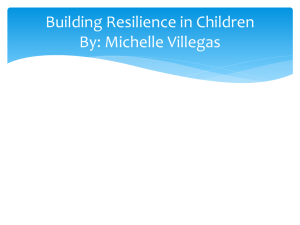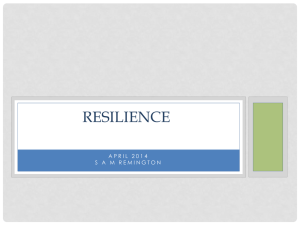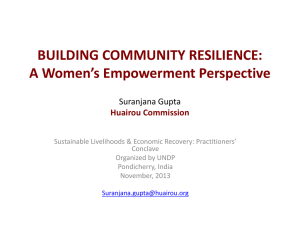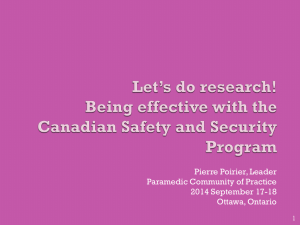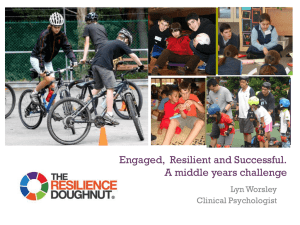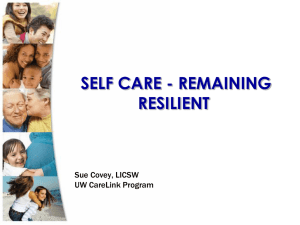CP1-resilience-final - Nevada Climate Change Portal
advertisement
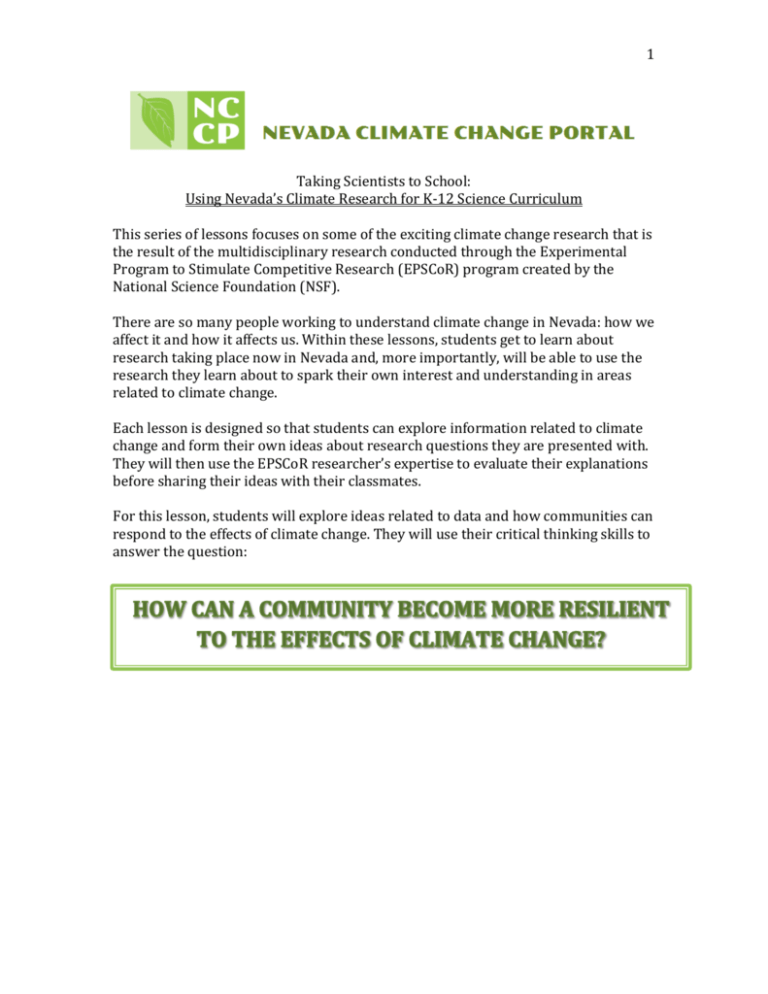
1 Taking Scientists to School: Using Nevada’s Climate Research for K-12 Science Curriculum This series of lessons focuses on some of the exciting climate change research that is the result of the multidisciplinary research conducted through the Experimental Program to Stimulate Competitive Research (EPSCoR) program created by the National Science Foundation (NSF). There are so many people working to understand climate change in Nevada: how we affect it and how it affects us. Within these lessons, students get to learn about research taking place now in Nevada and, more importantly, will be able to use the research they learn about to spark their own interest and understanding in areas related to climate change. Each lesson is designed so that students can explore information related to climate change and form their own ideas about research questions they are presented with. They will then use the EPSCoR researcher’s expertise to evaluate their explanations before sharing their ideas with their classmates. For this lesson, students will explore ideas related to data and how communities can respond to the effects of climate change. They will use their critical thinking skills to answer the question: 2 Time to complete: 4 to 6 days Grade level: 9th to 12th grades Standards: NGSS: Science and Engineering Practices: Asking questions Planning and carrying out investigations Constructing explanations Engaging in argument from evidence Obtaining, evaluating, and communicating information Disciplinary Core Ideas: HS-ESS3-1: Construct an explanation based on evidence for how the availability of natural resources, occurrence of natural hazards, and changes in climate have influenced human activity. HS-ESS3-4: Evaluate or refine a technological solution that reduces impacts of human activities on natural systems. Crosscutting Concepts: Patterns Cause and effect Systems and systems models Structure and function Stability and Change 3 INTRODUCTION What does it mean to be resilient? Let’s say you get the flu, but you are healthy and back to your normal activities in no time. Doctors might say your body was resilient to the effects of the illness. Or maybe you are normally an excellent student, but have a few bad test grades because of some distractions outside of school. Your overall grade will probably be pretty resilient to those impacts because of all of the hard work you did before. Dr. Derek Kauneckis and his fellow researchers at the University of Nevada in Reno have been studying the idea of resilience on a much larger scale. They want to know what it means for a community to be resilient to the effects of climate change and how resilient community organizations think they are. For this lesson, you will be exploring the same ideas to make claims about what YOU think it means to be resilient to climate change and what we can do in our communities to ensure that we are. How This Lesson Works This lesson is focused on a Big Question. The activities are divided into different sections or features. 1. With feature one of the lesson, you will be asked to respond with your initial ideas related to the Big Question. In every additional feature of the lesson, you have the opportunity to provide any further thoughts or questions that arise. 2. Feature two of the lesson is an activity where you are required to collect and explore some evidence related to the science content of the Big Question. This evidence is used throughout the remaining features of the lesson. 3. Feature three of the lesson involves analyzing your evidence and using it to generate an explanation (also called a claim) about the scientific ideas of the lesson. Typically, your analysis will produce an artifact that you will describe and justify to your peers and teacher at Research Council. 4. The accepted scientific understanding of the lesson is presented in feature four. In addition to demonstrating a thorough understanding of the scientific knowledge of the content, you will be asked to compare and contrast your explanation from feature two. 5. Finally, feature five of the lesson involves sharing and justifying your explanation and artifact from feature three among your peers and with your teacher at Research Council. The culminating activity of the lesson is to reflect on the Big Question of feature one and synthesize your understanding by using your evidence to compare and contrast your ideas with those of your peers and teacher. 4 The Big Question In this lesson you will explore the Big Question below and work through five different steps to address it. At certain points, you will be asked to complete a few activities like: reading, responding to some thoughtful questions, and adding to your research brief. You should take your time and think carefully about each step and your work and feel free to revisit any step at any time. We will review the concepts in class. The Big Question: HOW CAN A COMMUNITY BECOME MORE RESILIENT TO THE EFFECTS OF CLIMATE CHANGE? 5 FEATURE 1: YOUR INITIAL IDEAS In order to think about how our community might become more resistant to the ideas of climate change, we need to explore two smaller questions: What is resilience? What do our communities do that we want to maintain? 1. Look at the images below. Think about the things that your community does for you. What services do communities provide? 2. Watch the video clips below to begin to think about the ideas of resilience and what it means to the services that communities provide. Communities adaptation to climate change: http://www.youtube.com/watch?v=T9UbAEfwZ8w South African businesses resilience: http://www.youtube.com/watch?v=r14ivmgPp7M Research Brief: Getting Started Use the following prompts to discuss some of your initial ideas about how carbon accumulates n the atmosphere, given the images and video you just looked at. 1. What services do our communities provide for us? I believe that my community does the following things for the people that live in it: 6 2. What does it mean for a community to be resilient to a change? Think about the services it provides that you just named. I believe that for a community to be resilient to change it will be able to … 7 FEATURE 2: EXPLORE THE EVIDENCE Task 1: Surfing the Waves of Change The following video discusses resilience on a few levels: personal, community and global. Consider how these types of resilience are related. Is it enough or even possible to have resilience on the community level only? Surfing the Waves of Change Research Brief: Use the following prompts to record some of your ideas about resilience after watching the video above. 3. How is resilient community different from a non-resilient community? A resilient community and a non-resilient community are different in the following ways… 4. Use the table below to name some of the characteristics of each type of resilience. Personal resilience Community resilience Global resilience 8 Task 2: Learning to Bounce Back The link below will take you to an article published in the New York Times on the importance of resilience in a community. Learning to Bounce Back Research Brief: Use the following prompts to discuss some of your ideas about resilience to climate change after reading the article, “Learning to Bounce Back.” 5. What are some important actions a community can take if they want to become more resilient to environmental impacts? To become more resilient to environmental disasters, I think communities should… 6. What are some environmental impacts communities will have to deal with as a result of climate change? Some of the environmental impacts of climate change include… Task 3: Case Studies-Flooding in Las Vegas, Flooding on the Truckee River, Drought in the Las Vegas Valley Read each of the following case studies. In each case, use what you have learned about resilience so far to consider the following questions: 1. What was the environmental impact the community was facing? 2. Was the community able to protect their people and services? 3. Could this community have done anything to have been more resilient to the environmental problem they faced? If so what? Discuss each of the ideas with a class partner and then record your thoughts using the table provided in your Research Brief below. 9 Case study #1: Flooding in Las Vegas Valley recovering from Tuesday’s record rainfall, road closures, power outages http://www.lasvegassun.com/news/2012/sep/11/flash-flood-watch-extended-lasvegas/ Case study #2: Planning ahead on the Truckee River Truckee River flood potential solidifies for Sunday, emergency declared http://www.rgj.com/viewart/20121201/NEWS/312010012/Truckee-River-floodpotential-solidifies-Sunday-emergency-declared Case study #3: Drought in the Las Vegas Valley As Drought Worsens, New Campaign Calls on Las Vegas Valley Communities to Take the 90 by 20 Pledge http://www.lasvegassun.com/community/press-releases/823/ Research Brief: Use the following table to organize your thoughts about resilience based on the articles above. Case Study Flooding in Las Vegas Flooding in Reno Drought in Las Vegas Environmental Impact? Community Protection? Were the resilient? 10 11 FEATURE 3: YOUR SCIENTIFIC CLAIMS Task 1: Describing resilience You have explored several pieces of evidence now on community resilience and climate change. Now connect the dots to describe how the characteristics exhibited by the communities you studied represent resilience or not. Use the table below to develop your claims. An example is provided. 1. 2. 3. 4. A characteristic of being/ not being resilient named in the articles was… This made the community … trying to achieve a 90 gallon per day usage rate in the Las Vegas Valley. resilient (resilient/not resilient) I knew they were (resilient /not resilient) because… planning ahead means that there will be enough resources to allow the community to recover from drought in the future. 12 Task 2: Your claims You have explored several pieces of evidence now on community resilience and climate change. You now must develop claim-evidence-reason statement for a minimum of 3 actions that you believe will make a community more resilient to the effects of climate change. Use the Evidence-Claim-Reason table below to develop your claims. An example is provided. 1. As evidenced by… I claim… Because… The level of drought experienced along the Colorado River that communities need to teach their residents to use less water as the climate changes we might have less rain, so we need to learn to use less so that we all have enough. 2. 3. 4. Use your completed ECR Table to create a claim statement for each action item you propose. Example: As evidenced by the level of drought experienced along the Colorado River, I claim that communities need to teach their residents to use less water, because as the climate changes we might have less rain, so we need to learn to use less so that we all have enough. Research Brief: Complete the following starter prompts in your Research Brief: Claim Statement Starter Prompts: 1. As evidenced by... I claim that ... because... 2. As evidenced by... I claim that ... because... 3. As evidenced by... I claim that ... because... 13 FEATURE 4: SCIENTIFIC UNDERSTANDING Use the link to the website below to better understand the way that experts in the filed think about a community’s resilience to the impacts of climate change. How do these ideas compare to you own? Community Resilience and Adaptation Research Brief: Now that you have completed the activity and considered the scientific perspective on a community’s resilience to climate change, look back to your initial response to the big question: HOW CAN A COMMUNITY BECOME MORE RESILIENT TO THE EFFECTS OF CLIMATE CHANGE? and describe how your ideas have changed. Include how your collected evidence from the four tasks used in this lesson influenced your ideas. 14 FEATURE 5: RESEARCH COUNCIL In this investigation, you explored the concepts of resilience and community in relation to the effects of climate change. Your preparation required you to consider possible changes our environment and how we might be able to respond to them. You have explored what kinds of services our communities provide. You did this by evaluating various videos and articles and considering your own life and the things that might be affected in it. Present your Research Brief at a Research Council comprised of your classmates. Explain and defend your findings. Critique the claims presented by other students and ask them to defend their understanding of resilience and what our communities might need to be more resilient to the effect of climate change. Compare your ideas with others, critically evaluate your understanding of the connection between our way of living, the climate, and our future, then make any changes or update your research brief as you feel is appropriate. Record the specific evidence and reasoning that caused you to want to make any changes. Research Brief: After Research Council, complete your Research Brief by finishing the following statements: My ideas are similar to others because . . . My ideas are different because . . . Note: Use your experience in this lesson and the evidence you collected to support your claims.


